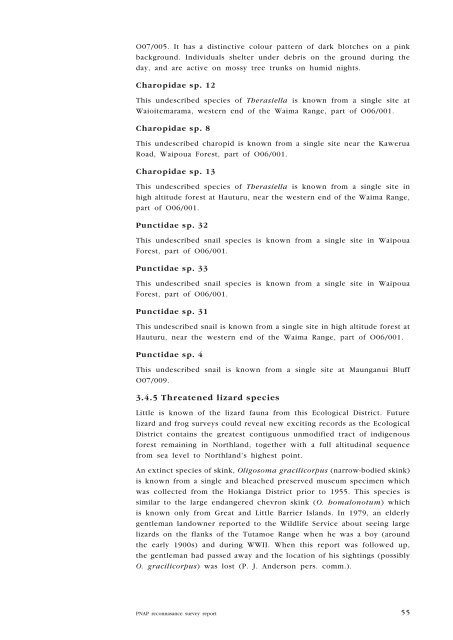Natural areas of Tutamoe Ecological District (3. Ecological character)
Natural areas of Tutamoe Ecological District (3. Ecological character)
Natural areas of Tutamoe Ecological District (3. Ecological character)
Create successful ePaper yourself
Turn your PDF publications into a flip-book with our unique Google optimized e-Paper software.
O07/005. It has a distinctive colour pattern <strong>of</strong> dark blotches on a pink<br />
background. Individuals shelter under debris on the ground during the<br />
day, and are active on mossy tree trunks on humid nights.<br />
Charopidae sp. 12<br />
This undescribed species <strong>of</strong> Therasiella is known from a single site at<br />
Waioitemarama, western end <strong>of</strong> the Waima Range, part <strong>of</strong> O06/001.<br />
Charopidae sp. 8<br />
This undescribed charopid is known from a single site near the Kawerua<br />
Road, Waipoua Forest, part <strong>of</strong> O06/001.<br />
Charopidae sp. 13<br />
This undescribed species <strong>of</strong> Therasiella is known from a single site in<br />
high altitude forest at Hauturu, near the western end <strong>of</strong> the Waima Range,<br />
part <strong>of</strong> O06/001.<br />
Punctidae sp. 32<br />
This undescribed snail species is known from a single site in Waipoua<br />
Forest, part <strong>of</strong> O06/001.<br />
Punctidae sp. 33<br />
This undescribed snail species is known from a single site in Waipoua<br />
Forest, part <strong>of</strong> O06/001.<br />
Punctidae sp. 31<br />
This undescribed snail is known from a single site in high altitude forest at<br />
Hauturu, near the western end <strong>of</strong> the Waima Range, part <strong>of</strong> O06/001.<br />
Punctidae sp. 4<br />
This undescribed snail is known from a single site at Maunganui Bluff<br />
O07/009.<br />
<strong>3.</strong>4.5 Threatened lizard species<br />
Little is known <strong>of</strong> the lizard fauna from this <strong>Ecological</strong> <strong>District</strong>. Future<br />
lizard and frog surveys could reveal new exciting records as the <strong>Ecological</strong><br />
<strong>District</strong> contains the greatest contiguous unmodified tract <strong>of</strong> indigenous<br />
forest remaining in Northland, together with a full altitudinal sequence<br />
from sea level to Northland’s highest point.<br />
An extinct species <strong>of</strong> skink, Oligosoma gracilicorpus (narrow-bodied skink)<br />
is known from a single and bleached preserved museum specimen which<br />
was collected from the Hokianga <strong>District</strong> prior to 1955. This species is<br />
similar to the large endangered chevron skink (O. homalonotum) which<br />
is known only from Great and Little Barrier Islands. In 1979, an elderly<br />
gentleman landowner reported to the Wildlife Service about seeing large<br />
lizards on the flanks <strong>of</strong> the <strong>Tutamoe</strong> Range when he was a boy (around<br />
the early 1900s) and during WWII. When this report was followed up,<br />
the gentleman had passed away and the location <strong>of</strong> his sightings (possibly<br />
O. gracilicorpus) was lost (P. J. Anderson pers. comm.).<br />
PNAP reconnasance survey report<br />
55

















